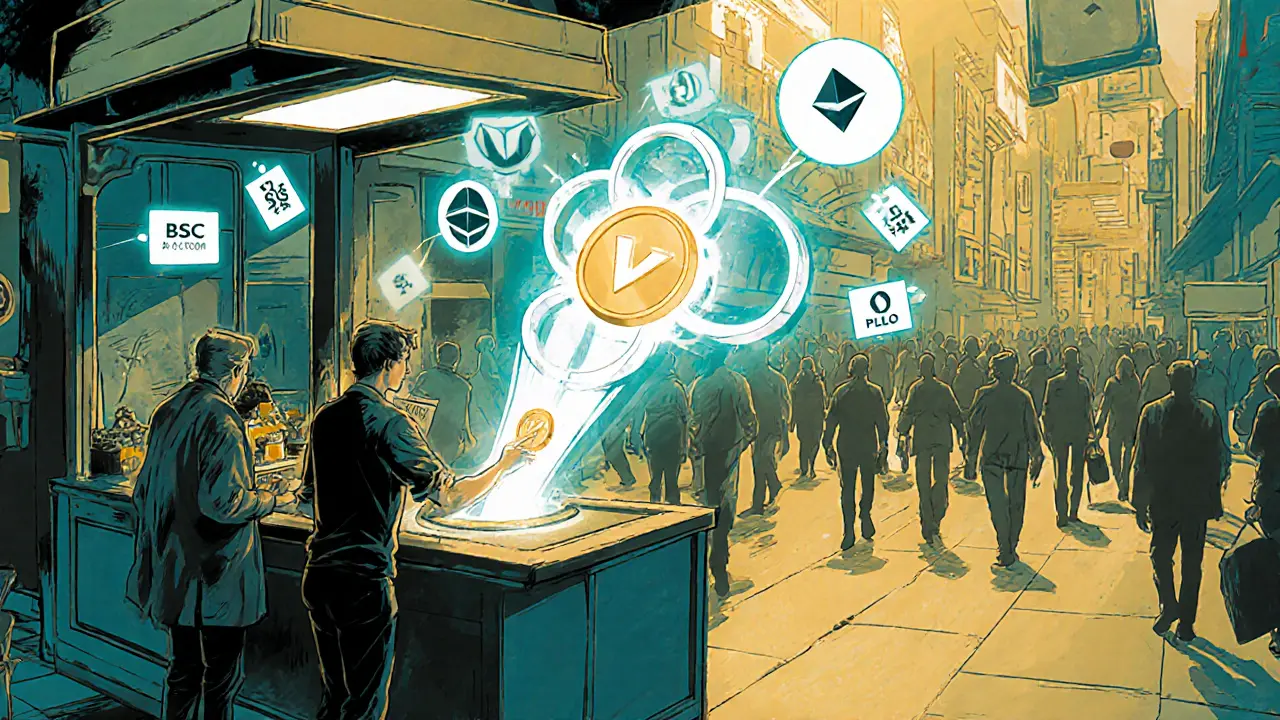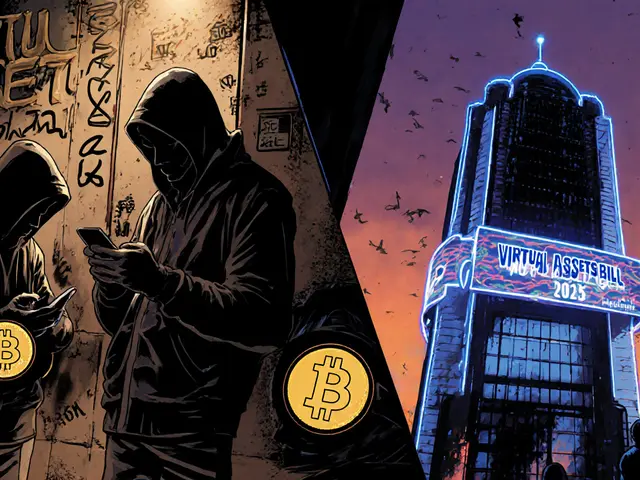- Home
- Cryptocurrency
- What Is Verge (XVG) Cryptocurrency? 2025 Guide to Features, Market and Future

What Is Verge (XVG) Cryptocurrency? 2025 Guide to Features, Market and Future
Verge (XVG) Value Calculator
As of October 2025: XVG price is €0.00497 (approx. $0.0054)
Transaction fees under $0.01 with 30-second block times
Enter amount to see value
Looking for a crypto that mixes fast, cheap payments with optional privacy? Verge (XVG) tries to fill that niche, offering a mix of Tor‑based anonymity, a switchable privacy layer, and a multi‑algorithm mining model.
Key Takeaways
- Verge is a privacy‑oriented coin launched in 2014, originally called DogeCoinDark.
- Its Wraith Protocol lets users toggle between transparent and private transactions.
- Five PoW algorithms (Scrypt, X17, Lyra2rev2, Myr‑Groestl, Blake2s) keep mining decentralised.
- As of October 2025 XVG has a circulating supply of 16.5 billion and a market cap around €82 million.
- Merchant adoption is growing, but exchange listings remain a pain point.
What Is Verge (XVG)?
Verge (XVG) is a decentralized digital currency that prioritises privacy and low‑cost, rapid payments. Founded in 2014 by a volunteer community and rebranded from DogeCoinDark in 2016, Verge never ran an ICO and was never pre‑mined, which appeals to users who value transparency. Its code lives publicly on GitHub, where 27 contributors have pushed recent updates.
Core Privacy Tech: Tor, I2P and the Wraith Protocol
Verge hides user IP addresses using two network‑layer tools:
- Tor routes traffic through a worldwide volunteer network to mask the origin IP.
- I2P provides an additional anonymity layer for peer‑to‑peer communication.
Both are built into the official Android wallet, letting users send transactions without exposing their location.
The standout feature is the Wraith Protocol a toggle that switches a transaction from public to private by using stealth addresses, key agreements and Tor/SSL encryption. Launched in 2018, it gives users the freedom to choose privacy on a per‑transaction basis, unlike Monero or Zcash where privacy is mandatory.
Consensus Mechanism: Multi‑Algorithm Proof‑of‑Work
Verge does not rely on a single mining algorithm. Instead it supports five PoW families-Scrypt, X17, Lyra2rev2, Myr‑Groestl and Blake2s-making it harder for ASIC manufacturers to dominate the network. This Proof‑of‑Work model secures the blockchain by requiring miners to solve cryptographic puzzles approach yields an average block time of 30 seconds and keeps fees below $0.01 per transaction.
The multi‑algorithm design also helps keep the network’s hash rate spread across diverse hardware, which aligns with Verge’s goal of decentralised mining.

Smart‑Contract Capability via RSK and Ethereum Compatibility
In 2022 Verge added support for the RSK a sidechain that brings Ethereum‑compatible smart contracts to Bitcoin‑like networks. This opened the door for decentralized apps, token swaps and DeFi features on XVG without abandoning its privacy focus.
2025 saw official bridges to Ethereum, Binance Smart Chain, Base and Polygon, meaning XVG can now move across major EVM‑compatible chains. The cross‑chain liquidity on Coinbase for XVGBASE is an early sign of broader ecosystem acceptance.
Market Snapshot (October 2025)
Key numbers at the time of writing:
- Circulating supply: 16,521,951,236 XVG
- Market cap: ~€81.9 million
- Current price: €0.00497 (≈ $0.0054)
- Annual inflation: ~0.03 % (no hard cap)
- Rank: #457 by market cap
Analyst forecasts vary: Godex.io sees a bullish path toward $0.20 by 2026, while BLOX keeps the 2025 outlook near €0.0051. The spread reflects both the niche nature of privacy coins and the volatility of exchange listings.
Use Cases and Merchant Adoption
Verge shines where low fees and optional privacy matter. Companies like Travala, Mobisun and AzireVPN already accept XVG, touting sub‑cent transaction costs. According to NOWPayments, merchants pay roughly 0.5 % processing fees with XVG versus 2.9 %+ for credit cards.
However, user surveys note that inconsistent acceptance remains a hurdle-only 0.8 % of enterprises reported regular XVG use, compared with 14 % for Bitcoin.
For everyday consumers, the Android wallet’s built‑in Tor makes a coffee‑shop payment feel seamless, as highlighted in a popular Reddit post where a user praised the “one‑tap privacy‑enabled payment”.

How Verge Stacks Up Against Other Privacy Coins
When you line up Verge with Monero (XMR), Zcash (ZEC) and Dash, a few patterns emerge:
- Monero forces privacy on every transaction; Verge lets you opt‑in.
- Zcash offers optional privacy via shielded addresses, but its privacy tech is more complex for newcomers.
- Dash focuses on speed and masternodes, with less emphasis on anonymity.
- Verge’s transaction speed (5‑10 seconds) is faster than Bitcoin’s 10‑minute average but slower than Ripple’s near‑instant finality.
- Fee‑wise, Verge’s <$0.01 fee beats Bitcoin’s $1.50 average and Ethereum’s volatile gas costs.
Market‑cap wise, XVG sits far behind the leaders-Monero’s $2.8 B vs XVG’s €82 M-so it remains a niche player.
Risks, Challenges and Future Outlook
Two major risks dominate discussions:
- Exchange listings. Between 2021‑2023 XVG was removed from 12 major exchanges, limiting liquidity and price stability.
- Regulatory pressure. Mandatory privacy coins face tighter AML/KYC rules in jurisdictions like South Korea; Verge’s optional privacy could be a safer bet, but regulators may still scrutinise network‑level anonymity tools.
Looking ahead, the roadmap targets atomic swaps and Lightning‑Network integration, both of which could boost scalability and merchant tooling. If the privacy‑friendly yet regulator‑compliant angle gains traction, XVG might climb out of its current #457 rank.
Getting Started with Verge
New users typically follow these steps:
- Download the official wallet (Windows, macOS, Linux or Android) from the Verge website.
- Run the installer and create a secure password; the wallet generates a seed phrase for backup.
- Fund the wallet by buying XVG on a supported exchange or receiving a transfer.
- Enable Tor or I2P in the settings if you want IP masking.
- Toggle the Wraith Protocol when you need a private transaction.
Most users report a successful setup within 15‑20 minutes, but the privacy toggle can be confusing at first-68 % of surveyed newcomers admitted they left it off initially.
Quick FAQ
Is Verge a privacy‑coin or a regular cryptocurrency?
Verge is a hybrid. It works like a normal crypto for everyday payments, but it offers the optional Wraith Protocol that can turn any transaction into a private one.
Do I need special hardware to mine Verge?
No. Because Verge supports five PoW algorithms, you can mine with GPUs, CPUs or even some ASICs, depending on the algorithm you choose.
How fast are XVG transactions?
Typical block confirmation takes 30 seconds, so most payments settle within 5‑10 seconds.
Can I use Verge on Ethereum?
Yes. Through the RSK sidechain and the 2025 bridges, XVG can be transferred to Ethereum, BSC, Base and Polygon networks.
Is Verge safe from government bans?
Because privacy is optional, Verge can often comply with AML/KYC requirements when needed, giving it a better chance of staying listed in stricter jurisdictions.
Whether you’re a casual user looking for cheap transfers or a developer eyeing smart‑contract integration, Verge offers a blend of speed, low fees and toggleable privacy that few other coins match today.
Cormac Riverton
I'm a blockchain analyst and private investor specializing in cryptocurrencies and equity markets. I research tokenomics, on-chain data, and market microstructure, and advise startups on exchange listings. I also write practical explainers and strategy notes for retail traders and fund teams. My work blends quantitative analysis with clear storytelling to make complex systems understandable.
10 Comments
Write a comment Cancel reply
About
DEX Maniac is your hub for blockchain knowledge, cryptocurrencies, and global markets. Explore guides on crypto coins, DeFi, and decentralized exchanges with clear, actionable insights. Compare crypto exchanges, track airdrop opportunities, and follow timely market analysis across crypto and stocks. Stay informed with curated news, tools, and insights for smarter decisions.




Verge gives you a choice, use it or not.
The optional privacy of Verge feels like a meditation on freedom – you can be transparent when you want, hidden when you need, and that flexibility is powerful 😊.
The Wraith Protocol lets you flip a switch; when it’s on, your transaction hides behind stealth addresses, when it’s off, it behaves like a normal payment.
One must, without doubt, acknowledge the profound engineering marvel that is Verge; its multi‑algorithm PoW architecture, which deftly distributes hashing power across five distinct families, stands as a testament to decentralisation, a principle that, in my estimation, is often under‑appreciated; moreover, the very existence of the Wraith Protocol-an opt‑in privacy layer-introduces a nuanced dialogue between transparency and anonymity, thereby challenging the binary perception that pervades many blockchain discussions; furthermore, the integration with RSK and cross‑chain bridges manifests a visionary approach to interoperability, undeniably positioning XVG at the vanguard of next‑generation digital assets; yet, despite these commendable attributes, the community must remain vigilant, for the specter of exchange delistings looms, threatening liquidity and adoption; consequently, a balanced critique acknowledges both the triumphs and the tribulations inherent to Verge’s evolution.
Ah, Verge-what a splendid tapestry of ambition and intrigue! In the grand theater of cryptocurrency, it strides onto the stage not merely as another token, but as a bold proclamation of optional privacy, a concept that resonates deeply in an era saturated with surveillance. Its genesis, rooted in the whimsical moniker DogeCoinDark, hints at a rebellious spirit that refuses to be shackled by convention. The Wraith Protocol, a masterstroke of engineering, offers users the tantalizing power to toggle between opacity and clarity, like a digital chameleon adapting to the ever‑changing light of the market. Five distinct PoW algorithms-Scrypt, X17, Lyra2rev2, Myr‑Groestl, Blake2s-form a symphony of computational diversity, thwarting the tyranny of ASIC dominance and preserving the egalitarian ethos of mining. One cannot overlook the strategic alliances forged through RSK, Ethereum‑compatible smart contracts, and recent bridges to Binance Smart Chain, Base, and Polygon-each a deliberate step toward ecosystem integration. Yet, the specter of limited exchange listings continues to haunt its trajectory, a reminder that adoption is as much a battle of perception as of technology. Merchants like Travala, Mobisun, and AzireVPN champion its utility, showcasing the practicality of micro‑transactions under a cent. Despite these triumphs, the market cap hovers modestly around €82 million, a figure that belies the potential embedded within its codebase. Analysts remain divided: bullish forecasts envision a meteoric rise to $0.20 by 2026, while cautious voices temper expectations at €0.0051. In summation, Verge stands as a polarizing figure-both a beacon of optional anonymity and a challenger to mainstream acceptance-inviting us to contemplate the delicate balance between privacy, speed, and scalability in the ever‑evolving cryptographic cosmos.
Behold, the seductive allure of Verge, cloaked in the glittering veneer of "optional privacy"-a phrase that, upon closer inspection, masks a deeper agenda of financial manipulation and covert surveillance! The very notion that one can simply flip a switch to hide transactions is a Pandora’s box, inviting the morally ambiguous to exploit anonymity for nefarious deeds. Let us not be fooled by the polished marketing; behind the curtain lies a network that, while promising liberty, subtly enforces conformity to the whims of hidden power brokers. The whispered promises of low fees and swift payments are but siren songs, luring the unsuspecting into a web of dependency on a cryptocurrency that thrives on obscurity. In the grand tapestry of crypto, Verge is but a thread woven by those who seek to obfuscate truth and perpetuate a culture of distrust.
Yo, check it – Verge’s multi‑algo mining is straight up fire, letting everything from GPUs to ASICs get in on the action. The integration with RSK gives us smart‑contract swag, while the Tor/I2P stack adds that stealth mode for privacy‑first peeps. Plus, the cross‑chain bridges make XVG a true lingua‑franca for DeFi ops. 💥
I hear you, and I’m really glad the community is sharing insights about Verge. It’s encouraging to see how the optional privacy feature can fit into everyday use without demanding a steep learning curve. Let’s keep the conversation supportive and help newcomers navigate the wallet and the Wraith switch.
Verge is a solid example of a crypto trying to blend accessibility with privacy. Its low transaction costs are perfect for micro‑payments, and the community vibe feels pretty welcoming. Looking forward to seeing more merchants hop on board.
this coin is a lil bit sus, alrdy rly tied 2 big casters and they pull thangs behind the scenes, dont trust the hype.